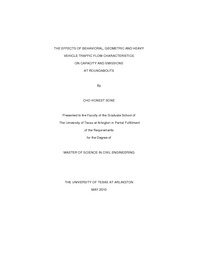
ATTENTION: The works hosted here are being migrated to a new repository that will consolidate resources, improve discoverability, and better show UTA's research impact on the global community. We will update authors as the migration progresses. Please see MavMatrix for more information.
Show simple item record
| dc.contributor.author | Sone, Cho Honest | en_US |
| dc.date.accessioned | 2010-11-01T21:28:48Z | |
| dc.date.available | 2010-11-01T21:28:48Z | |
| dc.date.issued | 2010-11-01 | |
| dc.date.submitted | January 2010 | en_US |
| dc.identifier.other | DISS-10725 | en_US |
| dc.identifier.uri | http://hdl.handle.net/10106/5117 | |
| dc.description.abstract | Modern roundabouts, first constructed in England in the early 1960s, are becoming increasingly popular replacements for signalized and stop controlled intersections in the United States. Roundabouts were introduced to replace traditional traffic circles and rotaries. With the characteristics of entering traffic that yield to circulating traffic and geometric constraints that slow entering vehicles, roundabouts have proven to be more efficient than traffic circles and in some cases than signalized and stop-controlled intersections. Roundabouts often require drivers to decelerate from, and reaccelerate to, highway speeds, and can involve one or multiple stops. One concern about congested roundabouts is that vehicle emissions will increase because of the occurrence of excessive delays, queue formation and speed change cycles for approaching traffic. These occurrences could have a significant impact on congestion and air quality in the surrounding urban area. There are many methodologies that allow the evaluation of roundabout capacity (analytical and statistical models) and emissions at roundabouts. Each of these techniques considers some aspects of the roundabout like geometric elements, vehicular flow and behavioral parameters. Due to the fact that each method is distinctively different from the other, obtained results are usually not similar. This thesis presents the results of a wide survey conducted on an ample range of roundabout scenarios by the use of the simulation model VISSIM. Each scenario describes a fixed roundabout scenario using the following variables: geometric element (inscribed circle radius); characteristics of traffic flow (percentage truck, turning movements of major and minor street) and behavioral features (time gap). These scenarios are then analyzed to see how these different parameters affect capacity and emissions at roundabouts. These parameters showed different relationships with both capacity and emissions. Radius had a positive effect, that is a direct relationship to capacity while truck percentage and time gap showed an inverse relationship to capacity. These parameters all showed a direct relationship with emissions generated. | en_US |
| dc.description.sponsorship | Williams, James C. | en_US |
| dc.language.iso | en | en_US |
| dc.publisher | Civil & Environmental Engineering | en_US |
| dc.title | The Effects Of Behavioral, Geometric And Heavy Vehicle Traffic Flow Characteristics On Capacity And Emissions At Roundabouts | en_US |
| dc.type | M.S. | en_US |
| dc.contributor.committeeChair | Williams, James C. | en_US |
| dc.degree.department | Civil & Environmental Engineering | en_US |
| dc.degree.discipline | Civil & Environmental Engineering | en_US |
| dc.degree.grantor | University of Texas at Arlington | en_US |
| dc.degree.level | masters | en_US |
| dc.degree.name | M.S. | en_US |
Files in this item
- Name:
- Sone_uta_2502M_10725.pdf
- Size:
- 1.714Mb
- Format:
- PDF
This item appears in the following Collection(s)
Show simple item record


